Pumping Station Desing - Second Edition by Robert L. Sanks, George Tchobahoglous, Garr M. Jones
Подождите немного. Документ загружается.

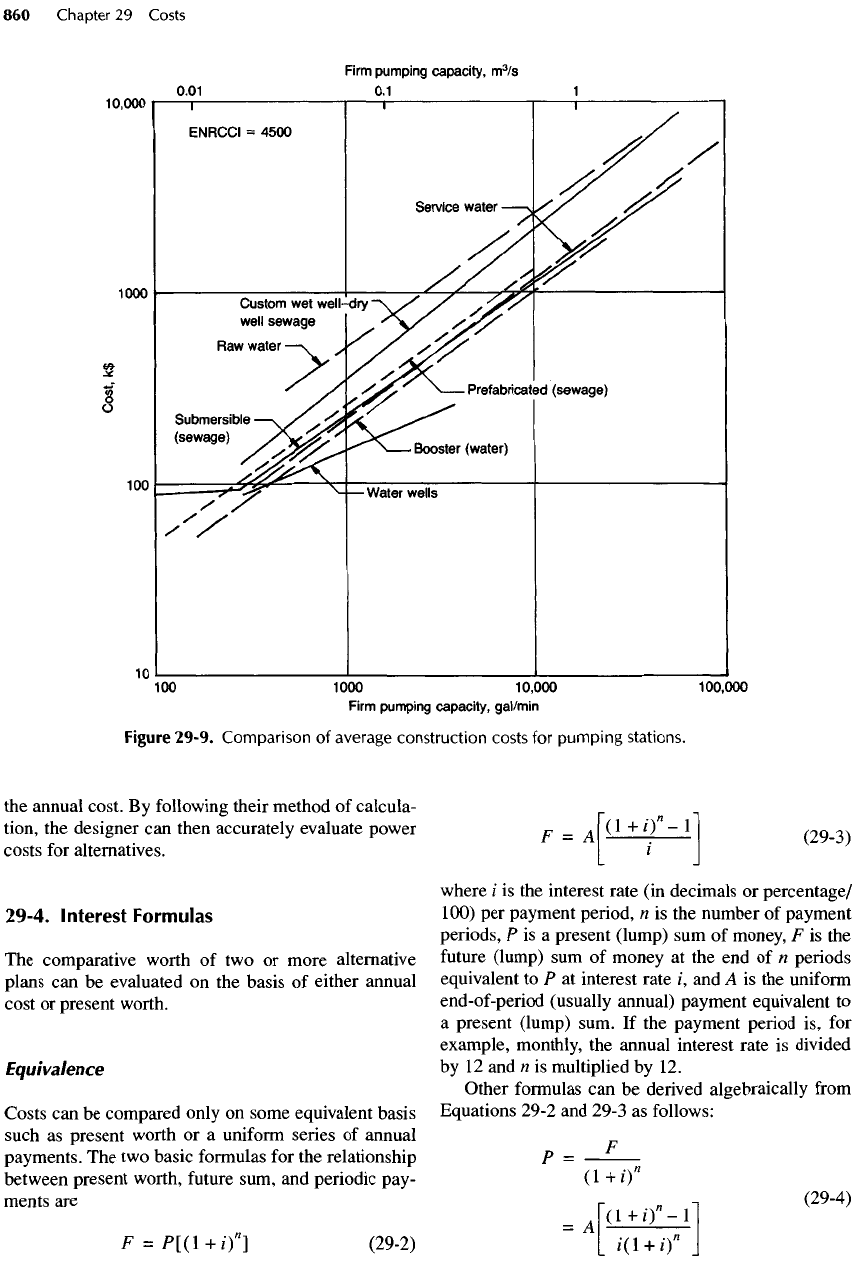
the
annual cost.
By
following their method
of
calcula-
tion,
the
designer
can
then accurately evaluate power
costs
for
alternatives.
29-4. Interest Formulas
The
comparative worth
of two or
more alternative
plans
can be
evaluated
on the
basis
of
either annual
cost
or
present worth.
Equivalence
Costs
can be
compared only
on
some equivalent basis
such
as
present worth
or a
uniform
series
of
annual
payments.
The two
basic formulas
for the
relationship
between present worth,
future
sum,
and
periodic pay-
ments
are
F =
Pf(I+/)"]
(29-2)
F =
Ap
1+
?"-
1
!
(29-3)
where
/
is the
interest rate
(in
decimals
or
percentage/
100)
per
payment period,
n is the
number
of
payment
periods,
P is a
present (lump)
sum of
money,
F is the
future
(lump)
sum of
money
at the end of n
periods
equivalent
to P at
interest
rate
/,
and A is the
uniform
end-of-period (usually annual) payment equivalent
to
a
present (lump) sum.
If the
payment period
is, for
example, monthly,
the
annual interest rate
is
divided
by
12 and n is
multiplied
by 12.
Other formulas
can be
derived algebraically
from
Equations
29-2
and
29-3
as
follows:
P=
F
d
+
O"
r
»
I
(
29
'
4
>
=
4
(1+0
1
I
L
/(1
+
O" J
Figure 29-9.
Comparison
of
average
construction
costs
for
pumping
stations.
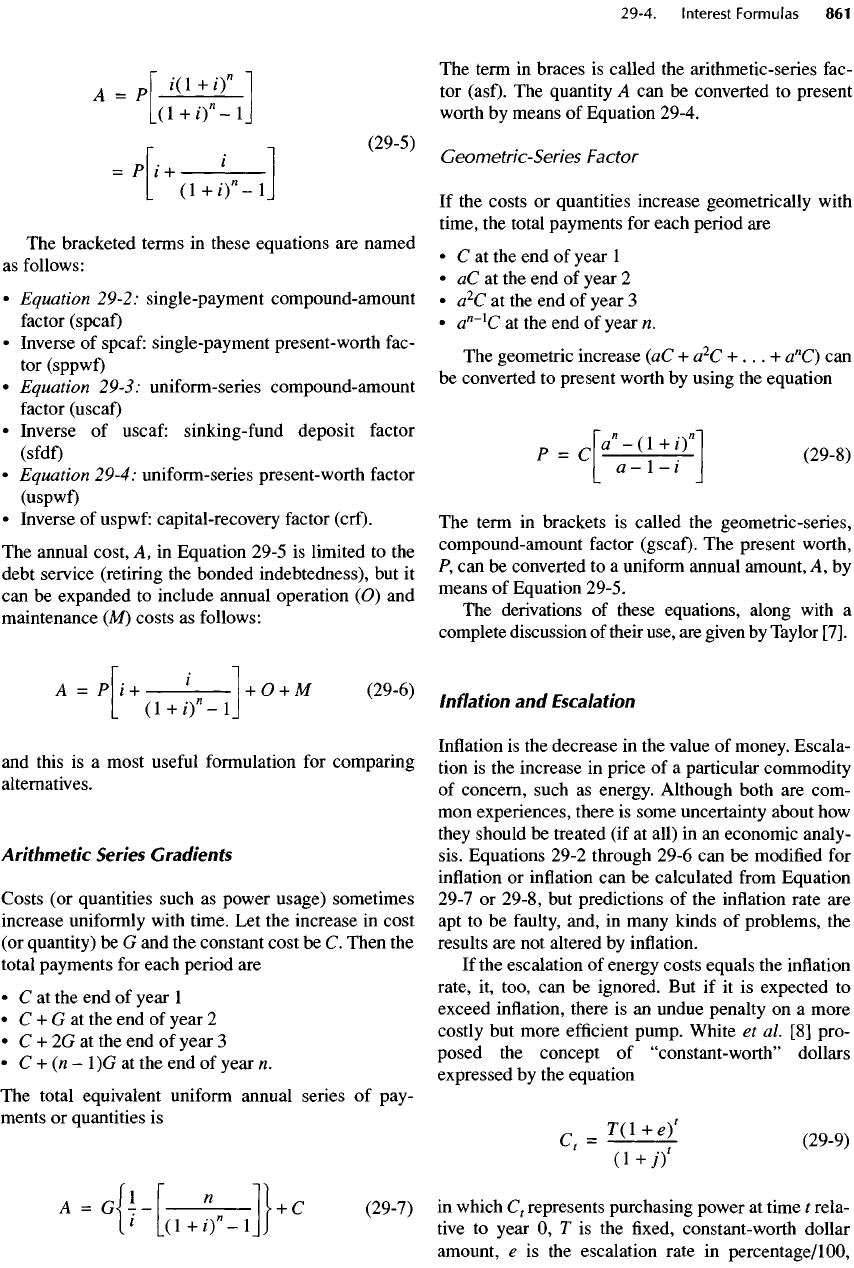
A
=
4'
(1+/)
"
1
Ld+o"-iJ
r
.
i
(
29
-
5
)
=
/>/
+
'
L
(i+o"-ij
The
bracketed terms
in
these equations
are
named
as
follows:
•
Equation
29-2:
single
-payment
compound-amount
factor
(spcaf)
•
Inverse
of
spcaf: single-payment
present-
worth
fac-
tor
(sppwf)
•
Equation
29-3:
uniform-series compound-amount
factor
(uscaf)
•
Inverse
of
uscaf:
sinking-fund
deposit
factor
(sfdf)
•
Equation 29-4:
uniform-
series
present-
worth
factor
(uspwf)
•
Inverse
of
uspwf: capital-recovery
factor
(erf).
The
annual cost,
A, in
Equation 29-5
is
limited
to the
debt service (retiring
the
bonded indebtedness),
but it
can be
expanded
to
include annual operation
(O) and
maintenance
(M)
costs
as
follows:
A-Pi+
l
+ 0 + M
(29-6)
.
(1
+
iT-lJ
and
this
is a
most
useful
formulation
for
comparing
alternatives.
Arithmetic
Series
Gradients
Costs
(or
quantities such
as
power usage) sometimes
increase
uniformly
with time.
Let the
increase
in
cost
(or
quantity)
be G and the
constant cost
be C.
Then
the
total payments
for
each period
are
• C at the end of
year
1
• C + G at the end of
year
2
• C + 2G at the end of
year
3
• C +
(n
-
I)G
at the end of
year
n.
The
total equivalent
uniform
annual series
of
pay-
ments
or
quantities
is
A
= G\
l
n
1
+ C
(29-7)
I*
Ld
+
'T-iJI
The
term
in
braces
is
called
the
arithmetic-series fac-
tor
(asf).
The
quantity
A can be
converted
to
present
worth
by
means
of
Equation 29-4.
Geometric-Series
Factor
If
the
costs
or
quantities increase geometrically with
time,
the
total payments
for
each
period
are
• C at the end of
year
1
• aC at the end of
year
2
•
O
2
C
at the end of
year
3
•
a
n
~
l
C
at the end of
year
n.
The
geometric increase
(aC +
O
2
C
+
.
.
.
+
a
n
C)
can
be
converted
to
present worth
by
using
the
equation
n
,+
'\n~\
P
=
C
a
-
(
\
+l
)
(29-8)
a— 1
—
i
The
term
in
brackets
is
called
the
geometric-series,
compound-amount
factor
(gscaf).
The
present worth,
P,
can be
converted
to a
uniform annual amount,
A, by
means
of
Equation 29-5.
The
derivations
of
these equations, along
with
a
complete discussion
of
their use,
are
given
by
Taylor
[7].
Inflation
and
Escalation
Inflation
is the
decrease
in the
value
of
money. Escala-
tion
is the
increase
in
price
of a
particular commodity
of
concern, such
as
energy. Although both
are
com-
mon
experiences, there
is
some uncertainty about
how
they
should
be
treated
(if at
all)
in an
economic analy-
sis. Equations 29-2 through 29-6
can be
modified
for
inflation
or
inflation
can be
calculated
from
Equation
29-7
or
29-8,
but
predictions
of the
inflation
rate
are
apt
to be
faulty,
and,
in
many kinds
of
problems,
the
results
are not
altered
by
inflation.
If
the
escalation
of
energy costs equals
the
inflation
rate,
it,
too,
can be
ignored.
But if it is
expected
to
exceed
inflation,
there
is an
undue penalty
on a
more
costly
but
more
efficient
pump. White
et
al.
[8]
pro-
posed
the
concept
of
"constant-worth"
dollars
expressed
by the
equation
Cf
=
T(l+e)
(29
_
9)
(1+7')'
in
which
C
t
represents purchasing power
at
time
t
rela-
tive
to
year
O, T is the fixed,
constant-worth dollar
amount,
e is the
escalation rate
in
percentage/
100,
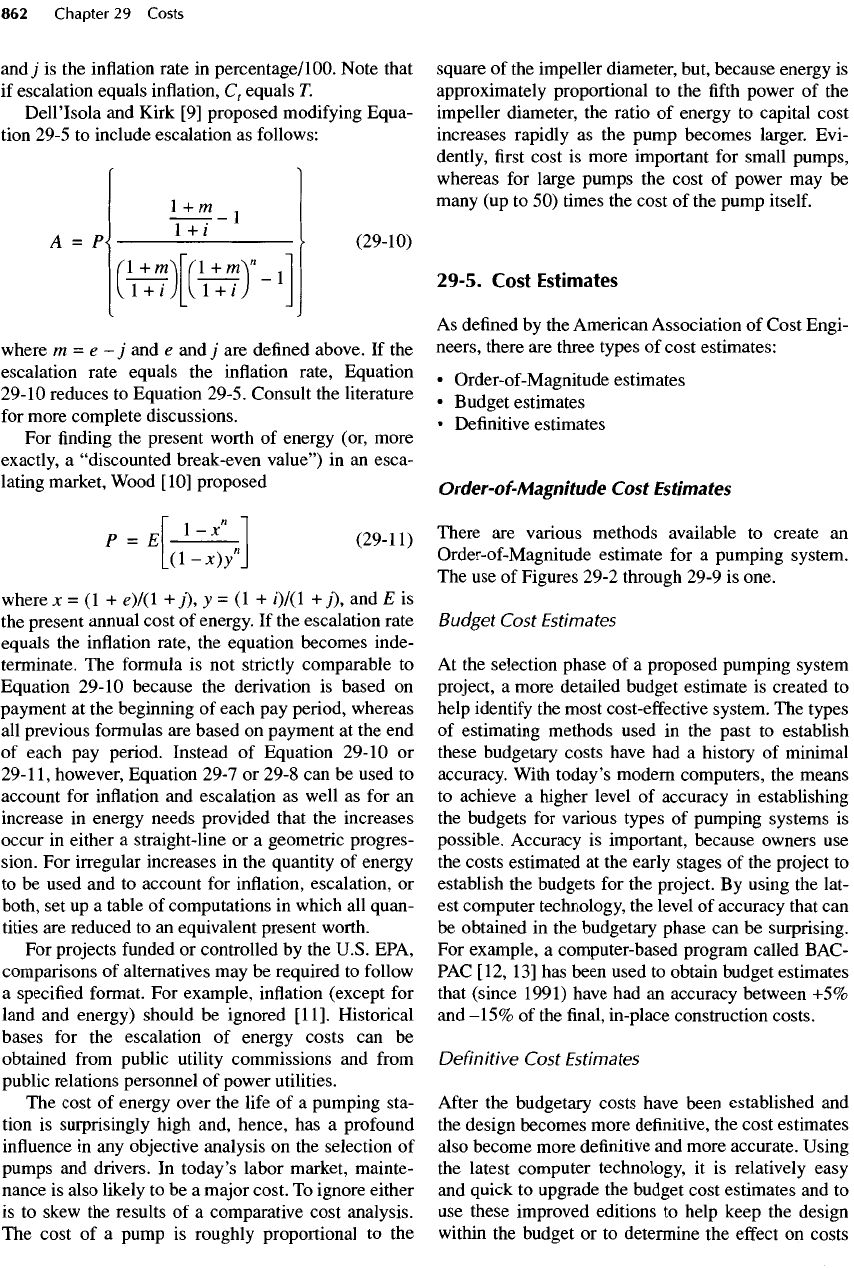
and;
is the
inflation
rate
in
percentage/
100.
Note that
if
escalation equals
inflation,
C
t
equals
T.
Dell'Isola
and
Kirk
[9]
proposed modifying Equa-
tion
29-5
to
include escalation
as
follows:
1
+m
.
A = P<
l+l
•
(29-10)
r
i+w
l[r
i+m
T-il
(i
+
ij[(i
+
ij
J
where
m-e-j
and e and
j
are
defined
above.
If the
escalation rate equals
the
inflation
rate, Equation
29-10
reduces
to
Equation 29-5. Consult
the
literature
for
more complete discussions.
For finding the
present worth
of
energy (or, more
exactly,
a
"discounted
break-even value")
in an
esca-
lating
market, Wood
[10]
proposed
1
n
1
P=E
(29-11)
Ld-*)/
J
where
x = (1 +
e)/(l
+y),
y = (1 +
/)/(!
+;'),
and E is
the
present annual cost
of
energy.
If the
escalation rate
equals
the
inflation
rate,
the
equation becomes inde-
terminate.
The
formula
is not
strictly comparable
to
Equation
29-10 because
the
derivation
is
based
on
payment
at the
beginning
of
each
pay
period, whereas
all
previous formulas
are
based
on
payment
at the end
of
each
pay
period. Instead
of
Equation 29-10
or
29-1
1,
however, Equation 29-7
or
29-8
can be
used
to
account
for
inflation
and
escalation
as
well
as for an
increase
in
energy needs provided that
the
increases
occur
in
either
a
straight-line
or a
geometric progres-
sion.
For
irregular increases
in the
quantity
of
energy
to be
used
and to
account
for
inflation,
escalation,
or
both,
set up a
table
of
computations
in
which
all
quan-
tities
are
reduced
to an
equivalent present worth.
For
projects
funded
or
controlled
by the
U.S. EPA,
comparisons
of
alternatives
may be
required
to
follow
a
specified
format.
For
example,
inflation
(except
for
land
and
energy) should
be
ignored
[U].
Historical
bases
for the
escalation
of
energy costs
can be
obtained
from
public
utility
commissions
and
from
public
relations personnel
of
power utilities.
The
cost
of
energy over
the
life
of a
pumping sta-
tion
is
surprisingly high and, hence,
has a
profound
influence
in any
objective analysis
on the
selection
of
pumps
and
drivers.
In
today's labor market, mainte-
nance
is
also likely
to be a
major
cost.
To
ignore either
is to
skew
the
results
of a
comparative cost analysis.
The
cost
of a
pump
is
roughly proportional
to the
square
of the
impeller diameter, but, because energy
is
approximately proportional
to the fifth
power
of the
impeller
diameter,
the
ratio
of
energy
to
capital cost
increases rapidly
as the
pump becomes larger. Evi-
dently,
first
cost
is
more important
for
small pumps,
whereas
for
large pumps
the
cost
of
power
may be
many
(up to 50)
times
the
cost
of the
pump
itself.
29-5. Cost
Estimates
As
defined
by the
American Association
of
Cost Engi-
neers,
there
are
three
types
of
cost
estimates:
•
Order-of-Magnitude estimates
•
Budget
estimates
•
Definitive estimates
Order-of-Magnitude
Cost
Estimates
There
are
various methods available
to
create
an
Order-of-Magnitude
estimate
for a
pumping system.
The use of
Figures 29-2 through 29-9
is
one.
Budget Cost Estimates
At
the
selection phase
of a
proposed pumping system
project,
a
more detailed budget estimate
is
created
to
help
identify
the
most cost-effective system.
The
types
of
estimating methods used
in the
past
to
establish
these budgetary costs have
had a
history
of
minimal
accuracy.
With today's modern computers,
the
means
to
achieve
a
higher level
of
accuracy
in
establishing
the
budgets
for
various types
of
pumping systems
is
possible. Accuracy
is
important, because owners
use
the
costs estimated
at the
early stages
of the
project
to
establish
the
budgets
for the
project.
By
using
the
lat-
est
computer technology,
the
level
of
accuracy that
can
be
obtained
in the
budgetary phase
can be
surprising.
For
example,
a
computer-based program called BAC-
PAC
[12,
13] has
been used
to
obtain budget estimates
that
(since
1991)
have
had an
accuracy between
+5%
and
-15%
of the final,
in-place
construction costs.
Definitive
Cost Estimates
After
the
budgetary costs have been established
and
the
design becomes more
definitive,
the
cost estimates
also become more
definitive
and
more accurate. Using
the
latest computer technology,
it is
relatively easy
and
quick
to
upgrade
the
budget cost estimates
and to
use
these improved editions
to
help keep
the
design
within
the
budget
or to
determine
the
effect
on
costs

that
various alternatives
can
have.
For
example, based
on
various soils conditions, BACPAC computes
the
thickness
and
cost
of
concrete
walls together with
the
amount
and
cost
of
reinforcement
automatically
—
the
reason
for
omitting
the
thickness
of
walls
in
Figures
29-12
and
29-15.
BACPAC
cost
estimates
for final
designs have
had an
historical accuracy (since 1991)
between
+2% and -5% of final,
in-place
costs.
During
the
design process,
it is
important
to
make
cost estimates
from
time
to
time
to
inform
both owner
and
designer
of the
consequences
of
various design
decisions
on the
cost
of the
project
and so
avoid over-
runs.
One
system
for
coping with this objective
is the
"Design-to-Cost"
system described
in
Section
1-10.
Regardless
of the
system used,
the final
cost esti-
mate
is
based
on a
complete listing
of the
quantities
of
all
materials described
in the
plans
and
specifications
multiplied
by the
prices
for
materials
and
labor plus
an
allowance
for the
contractor's
profit
and
overhead.
Even with
a
computer program, good estimating
requires great skill
and an
intimate knowledge
of
con-
struction
practices
and
market conditions.
An
appren-
tice, however,
if
careful
to
miss nothing,
can
make
reasonably acceptable estimates with
the
help
of
cur-
rent
publications
that
are
updated annually.
Useful
and
authoritative publications include Richardson stan-
dards [4], Means [14, 15],
and the
Dodge Cost Sys-
tems
[16].
Means
is
particularly
useful
for
buildings,
and
the
Dodge Cost Systems includes
heavy
construc-
tion
and
remodeling. Richardson
(1) has the
most
complete
and
extensive cost estimating publication
[4];
(2) has
developed
a
rapid estimating system;
and
(3)
provides
3- and
5-day seminars
in
cost estimating.
Walski
[17] discusses costs
for
planning. European
engineers
may find the
publications
of the
Water
Research Centre [18]
useful.
Articles such
as
that
by
Hall
et
al.
[19]
can
remain
useful
for
many
years
if the
costs
are
updated
by the
ENRCCI
[I].
Obtain prices
from
manufacturers wherever possi-
ble. List prices
are
usually
reduced
by
large percent-
ages
that
depend
on the
customer.
The
"customer"
for
a
pumping station
is the
general contractor
or a
sub-
contractor. Shipping
and
installation costs (including
profit
and
overhead)
must
be
added
to the
manufac-
turer's cost. Installation involves
(1)
anchoring
the
unit
in
place;
(2)
"hooking
up" to
pipes, conduits,
and
elec-
tricity;
and (3)
start-up
and
testing. Installation costs
are
often
surprisingly high even
for a
skid-mounted
unit.
Depending
on the
size
of a
machine
or
device
and
the
complexity
of the
hook-up, typical installation
costs might normally range
from
10 to 40% of the
pur-
chase
price,
but the
cost
can be
either less
or
more (see
Richardson [4], Means [14, 15],
or
Dodge
[16]).
Costs
are
affected
by
many factors, including
•
Competition
and
bidding climate
•
Accessibility
to a
labor market [remote
locations
cause
an
increase
in
labor
prices
—
about
10% for
every
48 km (30 mi) of
travel]
•
Foundation conditions
(dewatering,
sheet piling,
unstable
soils,
rock excavation)
•
Earthquake resistance
•
Surrounding conditions (such
as
nearby buildings,
buried conduits, etc.)
•
Need
for
standby power
•
Whether
the
owner
is a
private
or
public agency.
Local contractors
can be of
great help
in
assigning
values
to
these
considerations
—
if
their cooperation
can
be
secured,
but
there
is no
substitute
for
develop-
ing
some appreciation
for
construction practices
and
the
problems confronting
a
contractor
who
must
do a
specified
job for a fixed
price.
Because
of
planning,
land
acquisition, legal
fees,
owner's involvement,
interest during construction, administrative costs
for
the
project, start-up, operational training,
and the
costs
for
spare parts,
the
total cost
to the
owner
is
about twice
the
contract
bid
price.
Comparative
Cost
Estimates
A
rational choice between alternative designs
can be
made only when life-cycle cost estimates
are
com-
pared. Basing decisions
on
capital
(construction)
costs
only
is
misleading.
To
obtain
a
direct measure
of
the
relative costs between
different
design alterna-
tives,
it is not
necessary, however,
to
include features
common
to all
alternatives.
Finally,
to
reach
a
decision
on
the
best
alternative
—
not
necessarily
the
cheap-
est
—
the
intangibles (which cannot
be
quantified
in
dollars) must also
be
considered. Intangibles include
(but
are not
limited
to)
historical reliability, construc-
tion time, operational
ease,
simplicity, esthetics, com-
patibility with other facilities,
familiarity,
and the
preferences
of the
owner, operators,
and
designer.
Life-Cycle
Cost
Life-cycle
cost
is the
combined cost
of
engineering,
design, construction,
and
equipment procurement
to
construct
and
activate
a
pumping station during year
1
plus
the
accumulated operational costs
of
energy,
maintenance,
and
repair
for the
established
life
of the
pumping
station. Depending upon
the
project circum-
stances,
the
life
of the
pumping station
can be
based
on
either economic
or
technical considerations. Important
factors
include cost
of
money (interest),
the
need
for
equipment repair,
inflation,
and
future
energy costs.
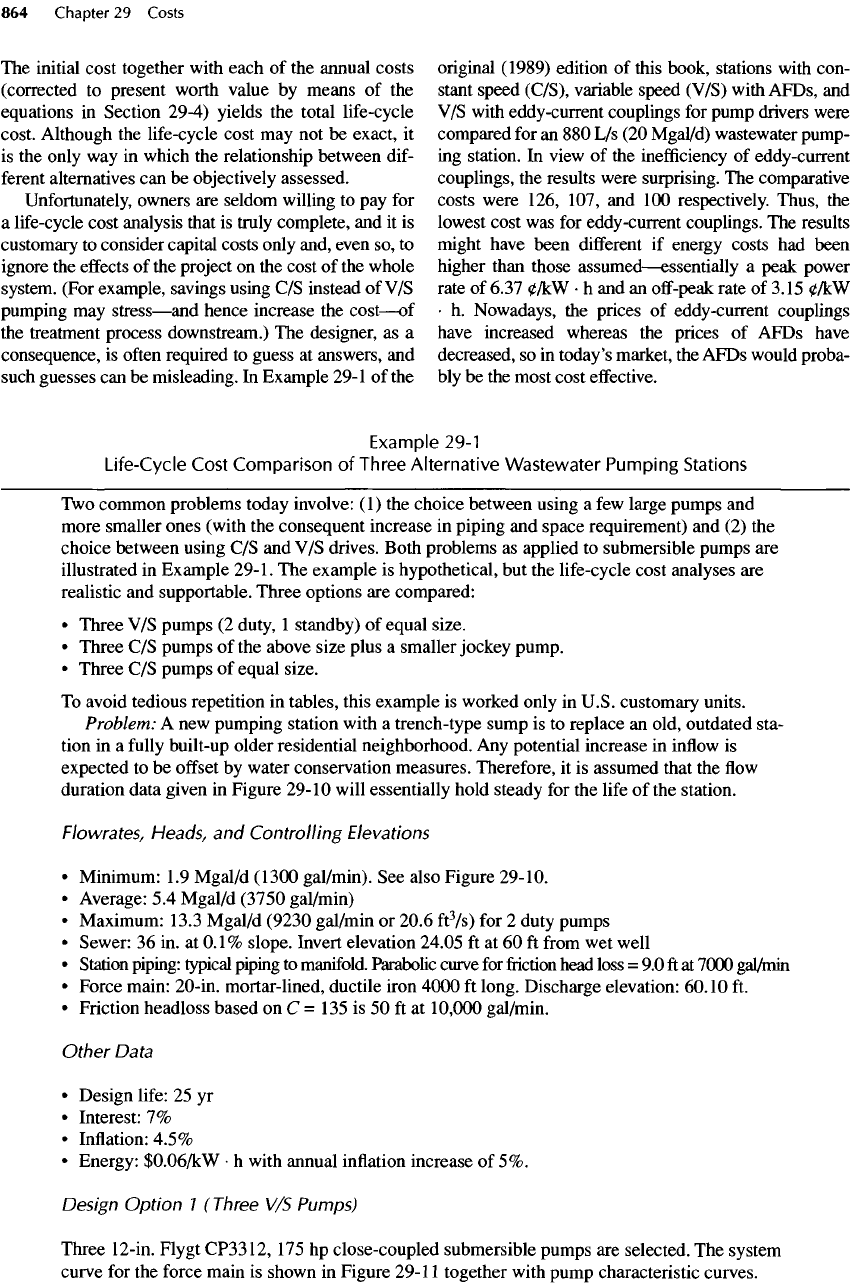
The
initial cost together with each
of the
annual costs
(corrected
to
present worth value
by
means
of the
equations
in
Section
29-4)
yields
the
total
life-cycle
cost. Although
the
life-cycle cost
may not be
exact,
it
is the
only
way in
which
the
relationship between dif-
ferent
alternatives
can be
objectively assessed.
Unfortunately,
owners
are
seldom willing
to pay for
a
life-cycle cost analysis that
is
truly
complete,
and it is
customary
to
consider capital costs only and, even
so, to
ignore
the
effects
of the
project
on the
cost
of the
whole
system.
(For example, savings using
C/S
instead
of V/S
pumping
may
stress
—
and
hence increase
the
cost
—
of
the
treatment process downstream.)
The
designer,
as a
consequence,
is
often
required
to
guess
at
answers,
and
such
guesses
can be
misleading.
In
Example 29-1
of the
original
(1989)
edition
of
this book, stations with con-
stant
speed (C/S), variable speed (V/S) with AFDs,
and
V/S
with eddy-current
couplings
for
pump drivers were
compared
for an 880 L/s (20
Mgal/d)
wastewater pump-
ing
station.
In
view
of the
inefficiency
of
eddy-current
couplings,
the
results were surprising.
The
comparative
costs were 126, 107,
and 100
respectively. Thus,
the
lowest cost
was for
eddy-current couplings.
The
results
might
have been
different
if
energy costs
had
been
higher than those
assumed
—
essentially
a
peak power
rate
of
6.37
eTkW
• h and an
off-peak
rate
of
3.15
0/kW
•
h.
Nowadays,
the
prices
of
eddy-current couplings
have
increased whereas
the
prices
of
AFDs have
decreased,
so in
today's
market,
the
AFDs would proba-
bly
be the
most cost
effective.
Example
29-1
Life-Cycle Cost Comparison
of
Three Alternative Wastewater Pumping Stations
Two
common problems today involve:
(1)
the
choice between using
a few
large pumps
and
more smaller ones (with
the
consequent
increase
in
piping
and
space requirement)
and (2) the
choice between using
C/S and V/S
drives. Both problems
as
applied
to
submersible pumps
are
illustrated
in
Example
29-1.
The
example
is
hypothetical,
but the
life-cycle cost analyses
are
realistic
and
supportable.
Three
options
are
compared:
•
Three
V/S
pumps
(2
duty,
1
standby)
of
equal size.
•
Three
C/S
pumps
of the
above size plus
a
smaller jockey pump.
•
Three
C/S
pumps
of
equal size.
To
avoid tedious repetition
in
tables, this example
is
worked only
in
U.S. customary units.
Problem:
A new
pumping station with
a
trench-type sump
is to
replace
an
old, outdated sta-
tion
in a
fully
built-up older residential neighborhood.
Any
potential increase
in
inflow
is
expected
to be
offset
by
water conservation measures. Therefore,
it is
assumed that
the flow
duration
data given
in
Figure
29-10
will essentially hold steady
for the
life
of the
station.
Flowrates,
Heads,
and
Controlling
Elevations
•
Minimum:
1.9
Mgal/d (1300
gal/min).
See
also Figure 29-10.
•
Average:
5.4
Mgal/d (3750 gal/min)
•
Maximum: 13.3 Mgal/d (9230 gal/min
or
20.6
ft
3
/s)
for 2
duty
pumps
•
Sewer:
36 in. at
0.1%
slope. Invert elevation
24.05
ft at 60 ft
from
wet
well
•
Station piping: typical piping
to
manifold.
Parabolic
curve
for
friction
head loss
= 9.0 ft at
7000
gal/min
•
Force main: 20-in. mortar-lined, ductile iron
4000
ft
long. Discharge elevation:
60.10
ft.
•
Friction headloss based
on C =
135
is 50 ft at
10,000
gal/min.
Other Data
•
Design
life:
25 yr
•
Interest:
7%
•
Inflation:
4.5%
•
Energy:
$0.06/kW
• h
with annual
inflation
increase
of
5%.
Design
Option
1
(Three
V/S
Pumps)
Three
12-in.
Flygt
CP3312,175
hp
close-coupled submersible pumps
are
selected.
The
system
curve
for the
force main
is
shown
in
Figure
29-11
together with pump characteristic curves.
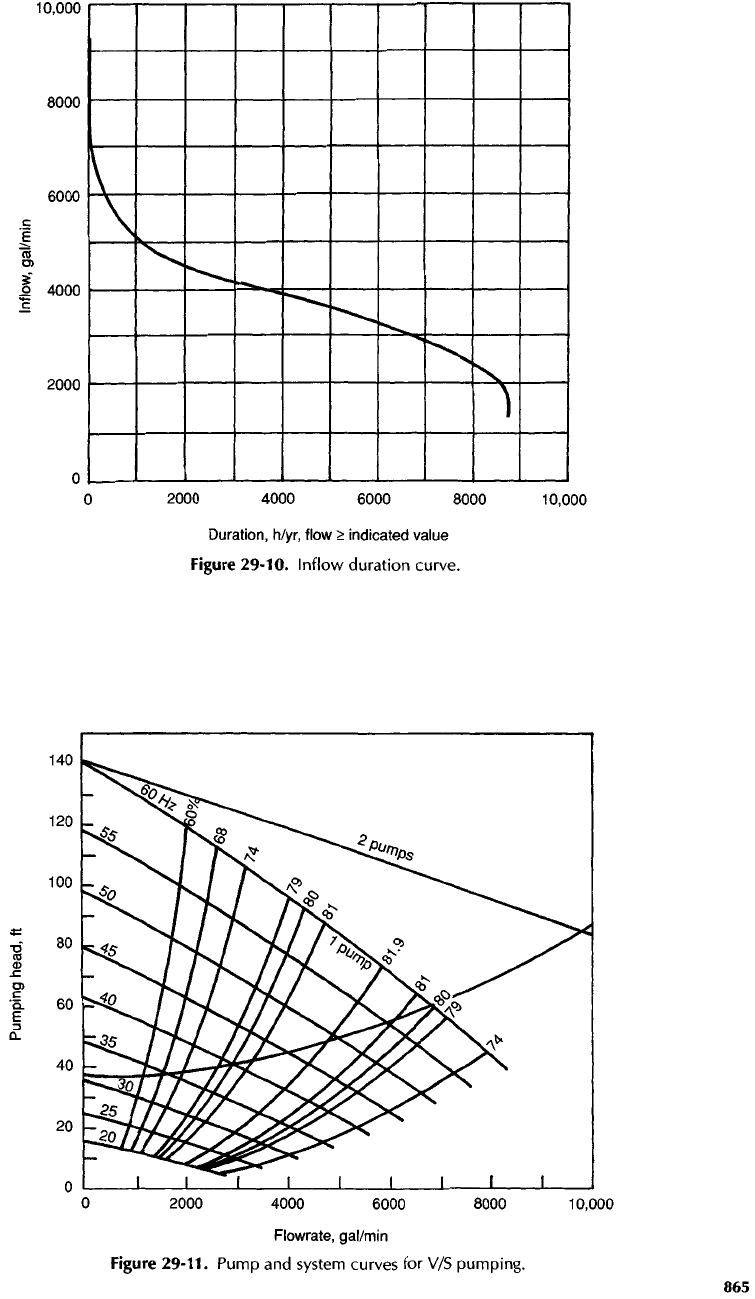
Figure
29-10. Inflow duration curve.
Figure
29-11.
Pump
and
system curves
for V/S
pumping.
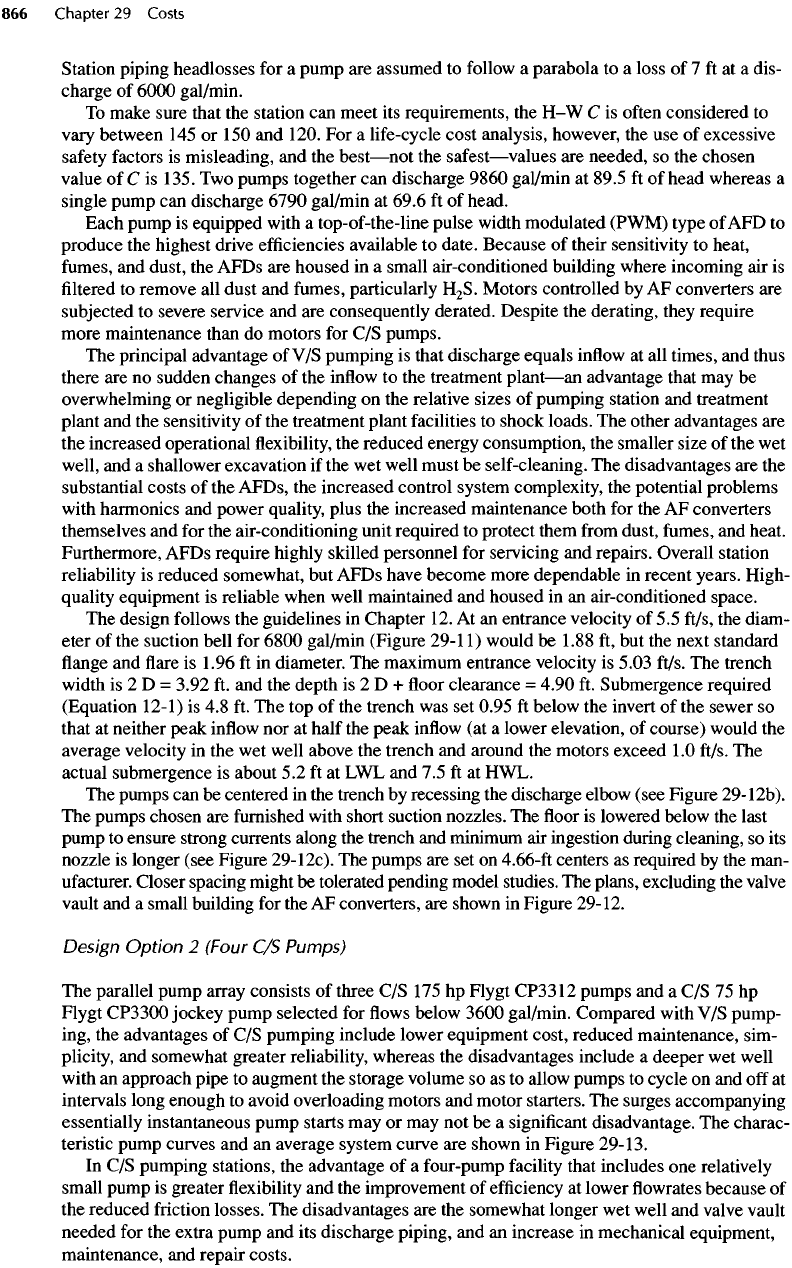
Station piping headlosses
for a
pump
are
assumed
to
follow
a
parabola
to a
loss
of 1
ft
at
a
dis-
charge
of
6000
gal/min.
To
make sure that
the
station
can
meet
its
requirements,
the H-W C is
often
considered
to
vary
between
145 or 150 and
120.
For a
life-cycle cost analysis, however,
the use of
excessive
safety
factors
is
misleading,
and the
best—not
the
safest—values
are
needed,
so the
chosen
value
of C is
135.
Two
pumps together
can
discharge
9860
gal/min
at
89.5
ft of
head whereas
a
single pump
can
discharge
6790
gal/min
at
69.6
ft of
head.
Each pump
is
equipped with
a
top-of-the-line
pulse width modulated (PWM) type
of AFD to
produce
the
highest drive
efficiencies
available
to
date. Because
of
their sensitivity
to
heat,
fumes,
and
dust,
the
AFDs
are
housed
in a
small air-conditioned building where incoming
air is
filtered to
remove
all
dust
and
fumes,
particularly
H
2
S.
Motors
controlled
by AF
converters
are
subjected
to
severe service
and are
consequently derated. Despite
the
derating, they require
more maintenance than
do
motors
for C/S
pumps.
The
principal advantage
of V/S
pumping
is
that discharge equals
inflow
at all
times,
and
thus
there
are no
sudden changes
of the
inflow
to the
treatment
plant—an
advantage that
may be
overwhelming
or
negligible depending
on the
relative sizes
of
pumping station
and
treatment
plant
and the
sensitivity
of the
treatment plant facilities
to
shock loads.
The
other advantages
are
the
increased operational
flexibility, the
reduced energy consumption,
the
smaller size
of the wet
well,
and a
shallower excavation
if the wet
well must
be
self-cleaning.
The
disadvantages
are the
substantial
costs
of the
AFDs,
the
increased control system complexity,
the
potential problems
with
harmonics
and
power quality, plus
the
increased maintenance both
for the AF
converters
themselves
and for the
air-conditioning unit required
to
protect
them
from
dust,
fumes,
and
heat.
Furthermore, AFDs require highly skilled personnel
for
servicing
and
repairs. Overall station
reliability
is
reduced somewhat,
but
AFDs have
become
more dependable
in
recent years. High-
quality equipment
is
reliable
when well maintained
and
housed
in an
air-conditioned space.
The
design
follows
the
guidelines
in
Chapter
12. At an
entrance velocity
of 5.5
ft/s,
the
diam-
eter
of the
suction bell
for
6800
gal/min (Figure
29-11)
would
be
1.88
ft, but the
next standard
flange
and
flare is
1.96
ft in
diameter.
The
maximum entrance velocity
is
5.03 ft/s.
The
trench
width
is 2 D =
3.92
ft. and the
depth
is 2 D + floor
clearance
=
4.90
ft.
Submergence required
(Equation 12-1)
is 4.8 ft. The top of the
trench
was set
0.95
ft
below
the
invert
of the
sewer
so
that
at
neither peak
inflow
nor at
half
the
peak
inflow
(at a
lower elevation,
of
course) would
the
average velocity
in the wet
well above
the
trench
and
around
the
motors exceed
1.0
ft/s.
The
actual submergence
is
about
5.2 ft at LWL and 7.5 ft at
HWL.
The
pumps
can be
centered
in the
trench
by
recessing
the
discharge elbow (see Figure
29-12b).
The
pumps chosen
are
furnished
with short suction nozzles.
The floor is
lowered below
the
last
pump
to
ensure strong currents along
the
trench
and
minimum
air
ingestion
during cleaning,
so its
nozzle
is
longer (see Figure
29-12c).
The
pumps
are set on
4.66-ft
centers
as
required
by the
man-
ufacturer.
Closer spacing might
be
tolerated pending model studies.
The
plans, excluding
the
valve
vault
and a
small building
for the AF
converters,
are
shown
in
Figure
29-12.
Design
Option
2
(Four
C/S
Pumps)
The
parallel pump array consists
of
three
C/S 175 hp
Flygt
CP3312
pumps
and a C/S 75 hp
Flygt
CP3300
jockey pump
selected
for flows
below
3600
gal/min. Compared with
V/S
pump-
ing,
the
advantages
of C/S
pumping include lower equipment cost, reduced maintenance, sim-
plicity,
and
somewhat greater reliability, whereas
the
disadvantages include
a
deeper
wet
well
with
an
approach pipe
to
augment
the
storage volume
so as to
allow pumps
to
cycle
on and
off
at
intervals long enough
to
avoid overloading motors
and
motor starters.
The
surges accompanying
essentially instantaneous pump starts
may or may not be a
significant
disadvantage.
The
charac-
teristic pump curves
and an
average system curve
are
shown
in
Figure
29-13.
In
C/S
pumping stations,
the
advantage
of a
four-pump facility that includes
one
relatively
small pump
is
greater
flexibility and the
improvement
of
efficiency
at
lower
flowrates
because
of
the
reduced
friction
losses.
The
disadvantages
are the
somewhat
longer
wet
well
and
valve vault
needed
for the
extra pump
and its
discharge piping,
and an
increase
in
mechanical equipment,
maintenance,
and
repair
costs.
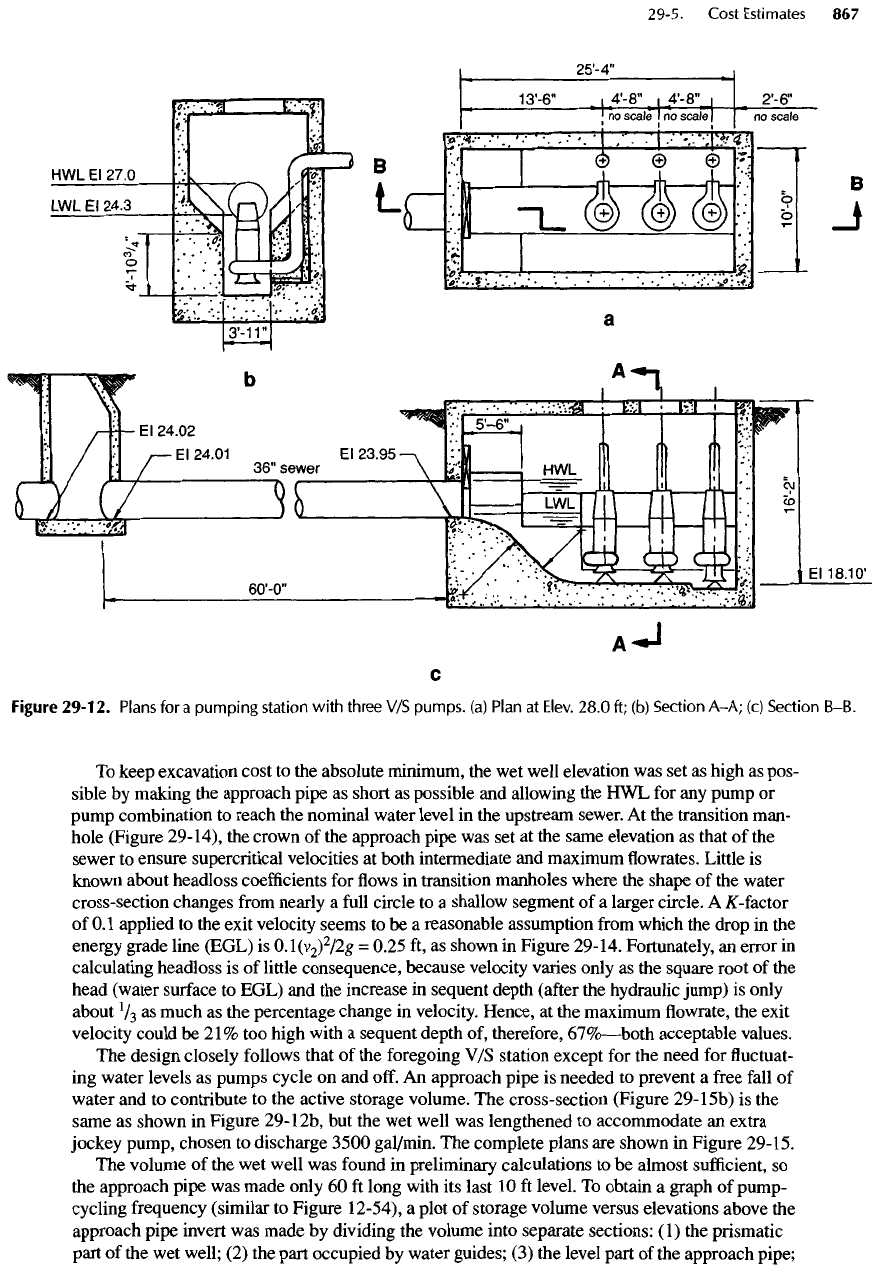
Figure
29-12.
Plans
for a
pumping
station
with
three
V/S
pumps,
(a)
Plan
at
Elev.
28.0
ft; (b)
Section
A-A;
(c)
Section
B-B.
To
keep excavation cost
to the
absolute minimum,
the wet
well elevation
was set as
high
as
pos-
sible
by
making
the
approach pipe
as
short
as
possible
and
allowing
the HWL for any
pump
or
pump
combination
to
reach
the
nominal water level
in the
upstream sewer.
At the
transition man-
hole (Figure 29-14),
the
crown
of the
approach pipe
was set at the
same elevation
as
that
of the
sewer
to
ensure supercritical velocities
at
both intermediate
and
maximum
flowrates.
Little
is
known
about
headless
coefficients
for flows in
transition manholes where
the
shape
of the
water
cross-section changes
from
nearly
a
full
circle
to a
shallow segment
of a
larger circle.
A
K-factor
of
0.1
applied
to the
exit velocity seems
to be a
reasonable assumption
from
which
the
drop
in the
energy
grade line (EGL)
is
0.1(v
2
)
2
/2g
=
0.25
ft, as
shown
in
Figure 29-14. Fortunately,
an
error
in
calculating
headless
is of
little consequence, because velocity varies only
as the
square root
of the
head (water
surface
to
EGL)
and the
increase
in
sequent depth
(after
the
hydraulic jump)
is
only
about
V
3
as
much
as the
percentage change
in
velocity. Hence,
at the
maximum
flowrate, the
exit
velocity could
be
21%
too
high with
a
sequent depth
of,
therefore,
67%—both
acceptable values.
The
design
closely
follows that
of the
foregoing
V/S
station except
for the
need
for fluctuat-
ing
water levels
as
pumps cycle
on and
off.
An
approach pipe
is
needed
to
prevent
a
free
fall
of
water
and to
contribute
to the
active storage volume.
The
cross-section (Figure
29-15b)
is the
same
as
shown
in
Figure
29-12b,
but the wet
well
was
lengthened
to
accommodate
an
extra
jockey pump, chosen
to
discharge
3500
gal/min.
The
complete
plans
are
shown
in
Figure
29-15.
The
volume
of the wet
well
was
found
in
preliminary calculations
to be
almost
sufficient,
so
the
approach pipe
was
made only
60 ft
long
with
its
last
10 ft
level.
To
obtain
a
graph
of
pump-
cycling
frequency
(similar
to
Figure 12-54),
a
plot
of
storage volume versus elevations above
the
approach
pipe
invert
was
made
by
dividing
the
volume into separate
sections:
(1) the
prismatic
part
of the wet
well;
(2) the
part occupied
by
water guides;
(3) the
level part
of the
approach pipe;
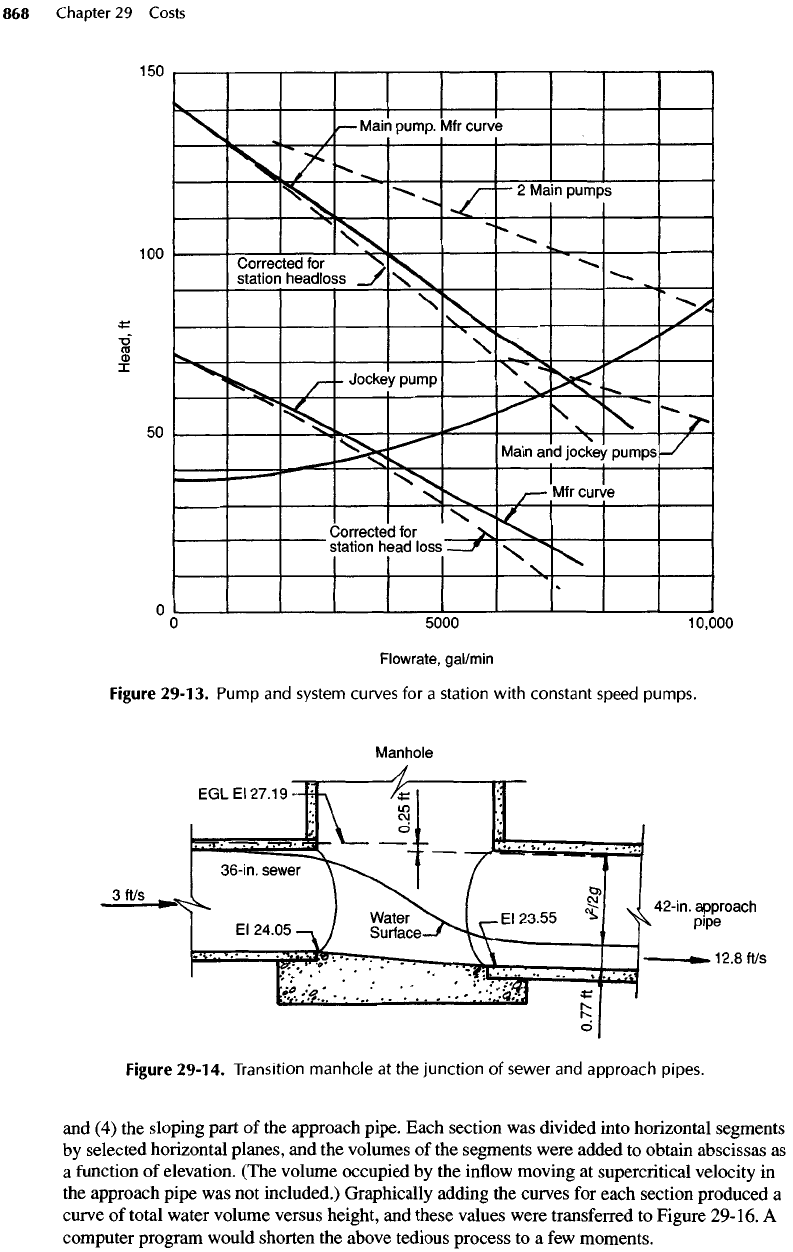
Figure
29-14.
Transition
manhole
at the
junction
of
sewer
and
approach
pipes.
and
(4) the
sloping part
of the
approach
pipe.
Each section
was
divided into horizontal segments
by
selected horizontal planes,
and the
volumes
of the
segments were added
to
obtain abscissas
as
a
function
of
elevation. (The volume occupied
by the
inflow
moving
at
supercritical velocity
in
the
approach pipe
was not
included.) Graphically adding
the
curves
for
each section produced
a
curve
of
total water volume versus height,
and
these values were transferred
to
Figure 29-16.
A
computer program would shorten
the
above tedious process
to a few
moments.
Figure
29-13.
Pump
and
system curves
for a
station
with
constant speed pumps.
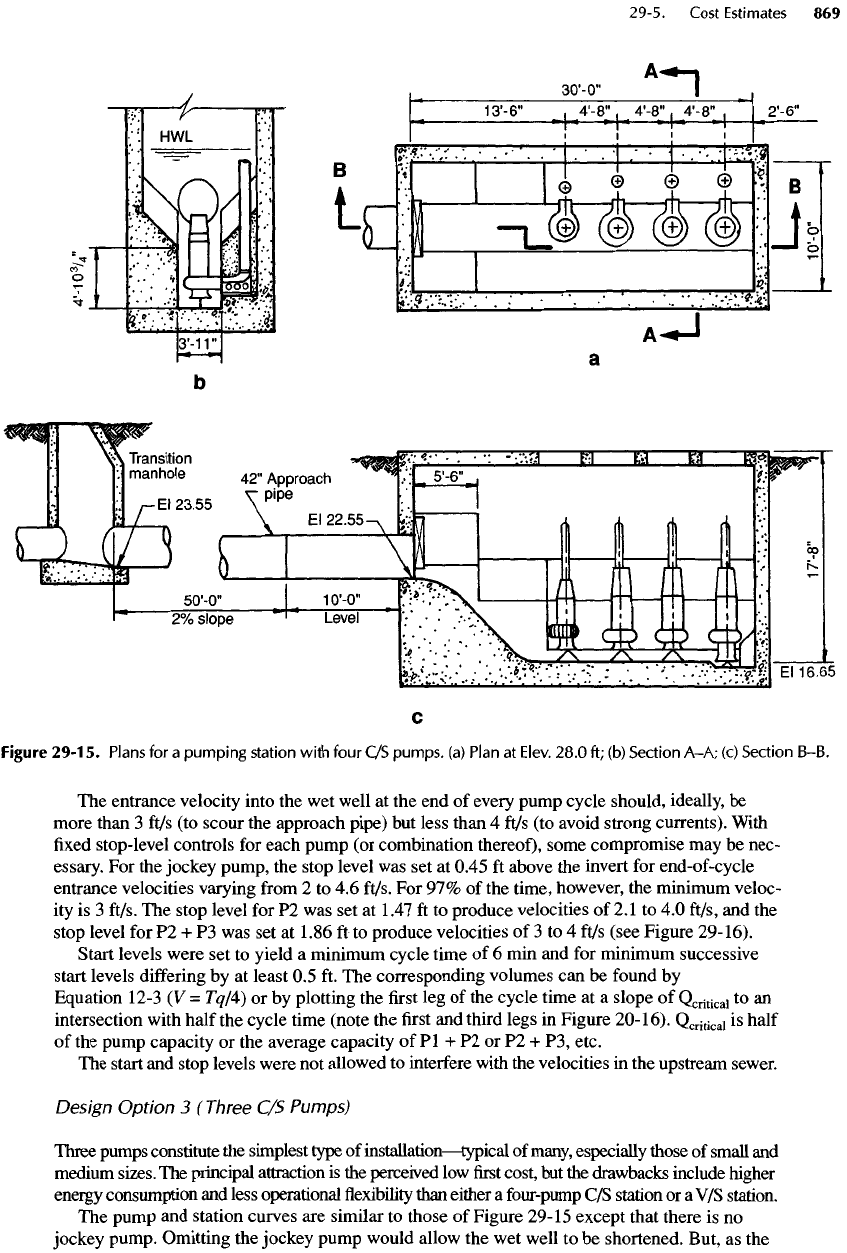
Figure
29-15.
Plans
for a
pumping
station
with
four
C/S
pumps,
(a)
Plan
at
Elev.
28.0
ft; (b)
Section
A-A;
(c)
Section
B-B.
The
entrance velocity into
the wet
well
at the end of
every pump cycle should, ideally,
be
more than
3
ft/s
(to
scour
the
approach pipe)
but
less than
4
ft/s
(to
avoid strong currents). With
fixed
stop-level controls
for
each pump
(or
combination thereof), some compromise
may be
nec-
essary.
For the
jockey pump,
the
stop level
was set at
0.45
ft
above
the
invert
for
end-of-cycle
entrance velocities varying
from
2 to 4.6
ft/s.
For 97% of the
time, however,
the
minimum veloc-
ity
is 3
ft/s.
The
stop level
for P2 was set at
1.47
ft to
produce velocities
of
2.1
to 4.0
ft/s,
and the
stop level
for P2 + P3 was set at
1.86
ft to
produce velocities
of 3 to 4
ft/s (see Figure
29-16).
Start levels were
set to
yield
a
minimum cycle time
of 6 min and for
minimum successive
start levels
differing
by at
least
0.5 ft. The
corresponding volumes
can be
found
by
Equation
12-3
(V =
Tq/4)
or by
plotting
the first leg of the
cycle time
at a
slope
of
Q
critical
to an
intersection with half
the
cycle time (note
the first and
third legs
in
Figure
20-16).
Q
critical
is
half
of
the
pump capacity
or the
average capacity
of Pl + P2 or P2 + P3,
etc.
The
start
and
stop levels were
not
allowed
to
interfere with
the
velocities
in the
upstream sewer.
Design
Option
3
(Three
C/S
Pumps)
Three pumps constitute
the
simplest type
of
installation—typical
of
many,
especially those
of
small
and
medium
sizes.
The
principal attraction
is the
perceived
low first
cost,
but the
drawbacks include higher
energy
consumption
and
less operational
flexibility
than
either
a
four-pump
C/S
station
or a V/S
station.
The
pump
and
station curves
are
similar
to
those
of
Figure
29-15
except that there
is no
jockey pump. Omitting
the
jockey pump would allow
the wet
well
to be
shortened. But,
as the
